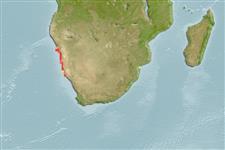>
Eupercaria/misc (Various families in series Eupercaria) >
Sparidae (Porgies)
Etymology: Chrysoblephus: Greek, chrysos = golden + Greek, blepo, blepharizo = to watch (Ref. 45335).
More on author: Valenciennes.
Environment: milieu / climate zone / rango de profundidad / distribution range
Ecología
marino demersal; rango de profundidad 1 - 100 m (Ref. 3198). Tropical; 21°S - 28°S
Southeast Atlantic: northern Namibia to northern Natal, South Africa; also reported from Mauritius.
Length at first maturity / Tamaño / Peso / Age
Madurez: Lm 18.1 range ? - 22.5 cm
Max length : 50.0 cm TL macho / no sexado; (Ref. 3507); common length : 32.0 cm TL macho / no sexado; (Ref. 3507); peso máximo publicado: 4.2 kg (Ref. 3670)
Short description
Claves de identificación | Morfología | Morfometría
Espinas dorsales (total) : 11 - 12; Radios blandos dorsales (total) : 10 - 11; Espinas anales: 3; Radios blandos anales: 7 - 9. Usually reddish orange in color, but sometimes blue with a white patch on the side (Ref. 3198).
Body shape (shape guide): short and / or deep.
Occurs above rocky bottoms in deeper water to 100 m but often caught from shore. Juveniles occur in shallow-water beds of seaweed where they feed on minute crustacean (Ref. 3670). Feeds on mollusks, crustaceans, worms and fish. Females transform into territorial males with growth (Ref. 3198). Voracious but sluggish, takes any bait. Good food fish (Ref. 3198). Sold fresh (Ref. 3507). It is parasitised by the monogenean Anoplodiscus cirrusspiralis on the fins and body surface (Ref. 124057).
Life cycle and mating behavior
Madurez | Reproducción | Puesta | Huevos | Fecundidad | Larva
Bauchot, M.-L. and M.M. Smith, 1984. Sparidae. In W. Fischer and G. Bianchi (eds.) FAO species identification sheets for fishery purposes. Western Indian Ocean (Fishing Area 51). volume 4. [var. pag.] FAO, Rome. (Ref. 3507)
IUCN Red List Status (Ref. 130435: Version 2025-1)
Threat to humans
Harmless
Human uses
Pesquerías: comercial; pesca deportiva: si; Acuario: Potencial
Herramientas
Special reports
Download XML
Fuentes de Internet
Estimates based on models
Phylogenetic diversity index (Referencia
82804): PD
50 = 0.5156 [Uniqueness, from 0.5 = low to 2.0 = high].
Bayesian length-weight: a=0.01778 (0.01102 - 0.02869), b=3.00 (2.86 - 3.14), in cm total length, based on LWR estimates for this species & Genus-body shape (Ref.
93245).
Nivel trófico (Referencia
69278): 4.0 ±0.0 se; based on diet studies.
Resiliencia (Referencia
120179): Medio, población duplicada en un tiempo mínimo de 1.4-4.4 años (K=0.16).
Fishing Vulnerability (Ref.
59153): Moderate to high vulnerability (54 of 100).
🛈
Nutrients (Ref.
124155): Calcium = 105 [50, 201] mg/100g; Iron = 0.941 [0.508, 1.907] mg/100g; Protein = 18.7 [17.4, 19.9] %; Omega3 = 0.199 [0.111, 0.369] g/100g; Selenium = 57.6 [26.0, 123.7] μg/100g; VitaminA = 14.8 [3.9, 54.0] μg/100g; Zinc = 0.862 [0.566, 1.286] mg/100g (wet weight);
